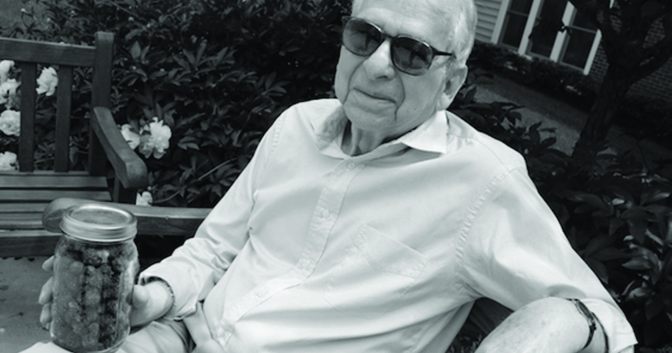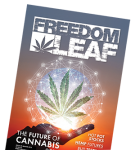Freedom Leaf Exclusive Interview: Dr. Lester Grinspoon

At 89, Dr. Lester Grinspoon is the patriarch of the marijuana-legalization movement. Born in Newton, Mass, in 1928, he attended Tufts University and Harvard Medical School; he’d go on to teach at the latter for more than 40 years. He’s the author and coauthor of numerous books, including the groundbreaking Marihuana Reconsidered (1971), Psychedelic Drugs Reconsidered (1979) and Marihuana: The Forbidden Medicine (1993). He was a member of NORML’s advisory board from 1976 to 1984 and on its board of directors from 1996 to 2000. Former NORML Executive Director Allen St. Pierre interviewed him at this home with his wife Betsy in Auburndale, Mass.
Unlike alcohol prohibition, which went from 1920-1933, why has cannabis prohibition lasted 80 years?
Pre-alcohol prohibition, the alcohol industry was relatively huge and influential in all quarters of American life. The manufacturers and sellers of alcohol have always possessed immense political power. Since alcohol production is so much more labor-intensive than cannabis, businesses had a strong interest in re-establishing alcohol commerce in America, and not having cheaply made competitors like cannabis be readily available for the masses.
During these 80 years of prohibition, essentially all meaningful opposition to reforming cannabis laws has come from either government—the Drug Enforcement Administration, National Institute on Drug Abuse and the Office of National Drug Control Policy—or so-called nonprofit groups that are largely funded by the government, such as the DARE program and the Partnership for a Drug-Free America. The government has suppressed scientific information and research about a plant that many believe, myself included, is, frankly, miraculous.
What could the cannabis-law reform movement have done better to hasten pot prohibition’s demise?
My contribution to the public discussion was the need for the government and the public to reconsider the cannabis policy, having science, not politics, largely guide the policymaking process. My first book on cannabis, Marihuana Reconsidered, was an attempt to start a public conversation, and all these years later, with 60% of Americans in public surveys supporting cannabis’ full legalization, I think it can safely be said that in the ensuing years since the book’s publication, America, and other parts of the world, have reconsidered prohibition and, thankfully, favor legalization now instead.
In the 1970s, NORML used to run ads in the media that compared marijuana to alcohol, tobacco and pills, asking the question, “Which of these drugs is most harmful?” I wish the organization could have kept running those ads, notably during the Reagan years.
Despite how long it’s taken to start to throw off the shackles of pot prohibition, the marijuana movement has much to be proud of in what is truly a “David vs. Goliath” struggle. With numerous states having legalized and taxed cannabis in the last several years, the federal government must be feeling serious pressure to end its long failed prohibition.
Of all the cannabis prohibitionists you’ve debated over the years, who was the most disingenuous and/or intellectually dishonest?
That’s easy: Dr. Gabriel Nahas, a professor of anesthesiology at Columbia University Medical School. No other individual pursued an anti-marijuana and anti-Lester Grinspoon agenda more than that man. Nahas would regularly harass and complain to the editors of scientific journals that published my work, attend conferences specifically to harangue me from the audience and insist to TV show bookers that they slate himself against me in a debate.
In the late 1970s, there was a general, cultural and political acceptance of cannabis’ inevitable legalization. Then President Reagan’s Just Say No focus considerably ratcheted up Nixon’s War on Drugs. How did this happen?
There were many contributing factors as to why cannabis and drug-policy reform on the whole hit the skids in the 1980s. Virtually all research protocols that examined any therapeutic effects of drugs like cannabis were immediately cancelled, and researchers like me were, for all and intents and purposes, blacklisted by NIDA and other government agencies. Most social and political reforms achieved by cannabis-law advocates in the 1970s stalled out in the worst possible ways in the Just Say No era.
What was the darkest period for cannabis-law reforms?
The 1980s marked cannabis-law reform’s nadir. The two drivers principally behind U.S. drug policy were large pharmaceutical interests and the federal government. The former, after investing billions in drug development that seeks exclusive marketing rights from the Food and Drug Administration, didn’t want a cheaply produced competitor in the form of cannabis, and the latter cranked out publicly funded anti-marijuana propaganda campaigns. The pharmaceutical companies and their government regulators were, in effect, in cahoots against cannabis.
As cannabis could not be patented, Big Pharma would rather fight it, since they couldn’t at the time see a way to make a profit from it. When I learned in the early 1990s that the Partnership for a Drug-Free America was an idea put forward by the pharmaceutical, alcohol and tobacco companies, I knew the deck was stacked against cannabis-law reform lock, stock and barrel.
Did you honestly believe you’d live to see the day when states would legalize marijuana?
Yes, and that the states were very likely going to lead the way against a recalcitrant federal government. It’s going to take a lot of states, likely a majority of them, to adopt legalization before the federal government gives up on their unpopular stance against marijuana.
When did the tide turn against pot prohibition?
The end of America’s prohibition on cannabis began in earnest after California voters, in the nation’s largest state, adopted medical access via the Prop 215 ballot initiative in 1996. Unsurprisingly, as more and more states either legalize or medicalize cannabis, the percentage of citizens surveyed nationally that favor it continues to rise to levels that elected policy-makers can no longer ignore in any state, and soon enough, maybe not in my lifetime, the federal government too. Now that California has passed legalization, I can’t imagine prohibition is long for this country as a whole. Sure, some states, like a Kansas or an Oklahoma, can continue to be foolish about cannabis, but most of the country will be post-pot prohibition sooner than later.
What are some of the factors that have led to cannabis legalization being favored today in public surveys by more than 60%, compared to 20% in 1990?
The three basic elements that have moved the country away from prohibition are activism, education and medical-cannabis advocacy. It’s hard to imagine cannabis prohibition ending without the existence of advocacy groups like National Organization for the Reform of Marijuana Laws, Drug Policy Alliance, American Civil Liberties Union, Marijuana Policy Project and others. Given their limited resources, the reform organizations did a far better job educating the public about cannabis than did federal and state governments—who spent billions of tax dollars annually trying to perpetuate pot prohibition. The focus on the therapeutic effects and safety of cannabis for medicine substantively changed the trajectory of the public debate, nationwide and globally.
What needs to be done to effectively cajole and pressure the federal government to follow the states’ lead in legalizing and regulating cannabis?
Nothing. States are going to continue to chip away at the federal government’s cannabis prohibition. I’m a strong believer that progress is inevitable among humans, observing often in my lifetime that progress is driven first by local and not national governments. The more state cannabis-law reforms, the faster national prohibition will conclude.
Post-federal prohibition, what do you envision as ideal cannabis policies?
Clearly, from the varied cannabis-reform policies that have emerged in a half-dozen states recently, there are numerous ways to craft new and purposeful cannabis policies. From Massachusetts’ heavily regulated legalization policy to Washington, D.C’s “depenalization” approach, they all share one basic tenet: Ending enforcement of cannabis prohibition. American society, working with public advocates and the emerging cannabis industry, will likely steer common-sense cannabis-related policymaking regarding driving, preventing youth access and deterring workplace impairment, more so than the government and law enforcement.
Who are some of your heroes that stood up against cannabis prohibition?
There are hundreds, maybe thousands of people that I’d count as my heroes when it comes to ending cannabis prohibition—certainly all of the pro-reform volunteers, protesters and organizations. However, two individuals that I hold in the highest regard for their contributions to this social struggle are NORML founder and public-interest lawyer Keith Stroup and WAMM (Wo/Men’s Alliance for Medical Marijuana) founder and patient Valerie Corral. Both have worked effectively and selflessly for decades on cannabis-law reform, not for fortune or fame, but because it was genuinely the right thing to do.
Do you expect a backlash against cannabis by Trump’s Justice Department, or will it be business as usual?
It will be business-as-usual going forward for marijuana-law reform and the hundreds of sanctioned marijuana growers and sellers at the state level. Trump can’t withstand the public backlash from consumers, patients and cannabis-related businesses, and now, because of the hundreds of millions annually they now derive from legal-and-taxed cannabis commerce, state and municipal governments whose citizens have voted affirmatively to end cannabis prohibition. Who, other than governmental anti-drug agencies, law enforcement and the drug-rehab industry still favors a continued prohibition on cannabis? The notion of re-banning cannabis commerce in America is getting to a place you can’t tread. In a word, cannabis legalization is now largely unstoppable.
If you enjoyed this Freedom Leaf article, subscribe to the magazine today!

